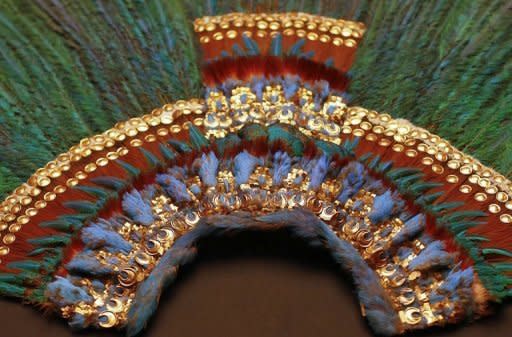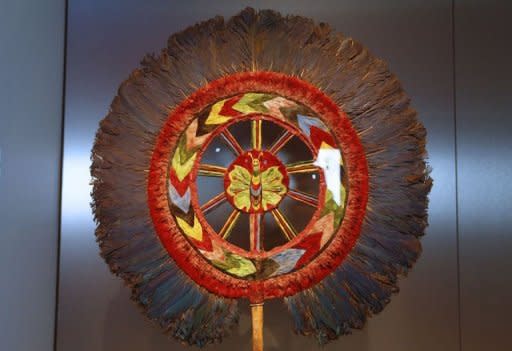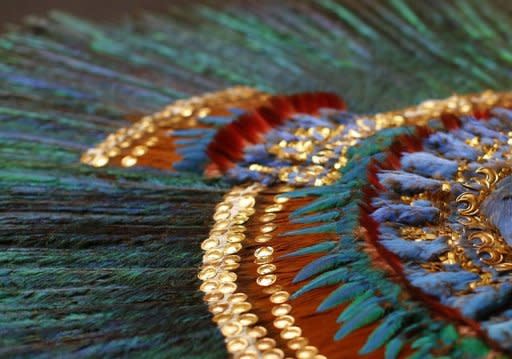Moctezuma headdress stirs passions in Mexico, Austria
Steeped in myth and legend, the "Penacho", a feather headdress supposedly worn by Aztec emperor Moctezuma II, continues to stir up passion in Austria and Mexico as it goes on display again after a years-long restoration. Some say it was brought to Europe by Spanish conquistador Hernan Cortes, others that it was used by an Aztec high priest. In any case, the vibrant green-and-blue headpiece -- the only one of its kind still in existence -- remains at the centre of a tug-of-war between Mexico, which wants to bring it home, and Austria, which argues it is too fragile to be transported. "This is only the beginning," Alfonso de Maria y Campos, director of Mexico's National Institute of Anthropology and History (INAH), said this week at a presentation of the restored Penacho in Vienna. "The initial thought behind this project continues to be the exhibition of this piece in Mexico," he added. First documented in 1596 in the collection of Tyrolean archduke Ferdinand II, the Penacho is one of the few surviving examples of ancient Mexican feather art, experts say. And despite being almost 500 years old, it has retained its brilliant colours. Some 450 iridescent green tail feathers from the rare quetzal bird were knotted together to form the 1.5-metre (five-foot) wide Penacho, embellished with gold adornments and smaller turquoise, red and brown feathers. This method of assembly means the headdress could easily fall apart during transportation or if exposed to vibrations, according to a new study by Vienna's University of Technology. And this is the "key issue" at the centre of any restitution or loan debate, Austria's foreign ministry says. "Everything depends on the question of whether it is transportable. If the answer is no, there is no second or third question" as to whether Austria would be willing to send the Penacho back to Mexico, ministry spokesman Martin Weiss told AFP. But de Maria y Campos, the INAH director, remains undeterred. "Mexico should be able to share the piece, granted that we find the best way to send it to Mexico fully protected of any harm," he told AFP. "We don't dispute the property or the possession." But "if we worked together to restore and study it, we can find a way to send it to Mexico to be exhibited." Gerard van Bussel, curator of the new Penacho exhibit at Vienna's Museum of Ethnology, agreed: "At the moment, it's unfortunately impossible, but who knows what might happen, what might become possible." Supporters of a loan note the Vienna university study focused on transportation by plane, leaving other options still open, and that changes in technology could facilitate shipment in the coming years. Former Mexican President Vicente Fox appealed to his Austrian counterpart Heinz Fischer to send the Penacho back during the latter's visit to Mexico in 2005, and indigenous Mexicans have repeatedly demanded the return of what they consider the "sacred crown of Moctezuma." Moctezuma II -- the now preferred name for Montezuma II -- was the last emperor of the Aztecs, ousted after the Spanish conquest of present-day Mexico. But Mexico has stopped short of a formal request for permanent restitution, with the INAH's director pushing instead for a "long loan." For him, the Penacho "belonged to Moctezuma, there is no doubt." It is also "most likely" that it was brought to Europe by Cortes. Other experts aren't so certain. "That's a myth, a fable. There's no evidence this is true," said van Bussel, who says the headdress was more likely used by a priest. While its origins remain a mystery, nobody denies the headpiece's beauty and uniqueness. Over the last two years, a large team of historians, archaeologists and ornithologists from Austria and Mexico have studied the Penacho, cleaning and preserving it for the future. It is now being exhibited alongside other rare featherworks from ancient Mexico, including a shield, a large fan and intricate religious images. It is the first time in eight years the headdress has been put on display. But the fragile headdress, held in a display case specially built to compensate for any movement caused by museum visitors walking around, remains the highlight of the exposition. "It's as if you see the Mona Lisa: it's crafted so particularly well, it's so beautifully done that it outshines the other objects," said de Maria y Campos. The return of the Penacho will likely continue to be discussed at bilateral meetings between Austria and Mexico, and a new treaty on cultural exchanges between the two countries is in the works. In the meantime, the continued presence in Vienna of the headdress -- a copy of which exists in Mexico City's Museum of Anthropology -- could have its benefits. "I can definitely understand that Mexico would like to have a piece like this in Mexico," van Bussel noted. "But I think it's also good publicity for Mexico if there are important objects from their Aztec culture in Europe."






